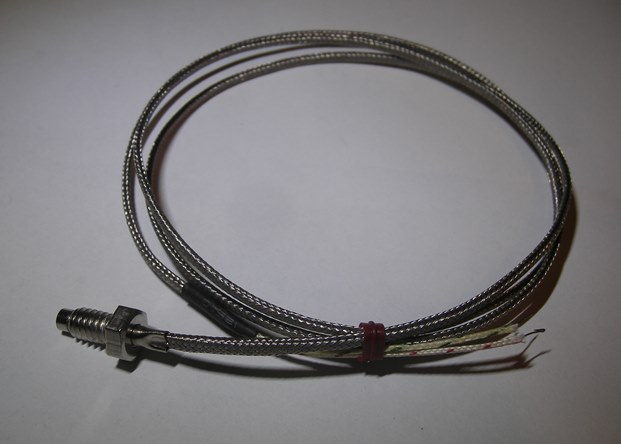I recently upgraded the exhaust system on my early model Jabiru 3300 and bought a complete new set of EGT senders. 6 times $60 = $360. That’s a pretty big outlay, but two of the old senders had failed, and I wanted to change from screw-in type to the hose-clamp type.
Here’s something I bought recently on eBay.
 The sender shown in the photo is advertised as a K-type thermocouple suitable for EGT measurement with a 6mm thread. Price was $1 each including postage – yes, that’s right – ONE DOLLAR. I bought 10 just to have a look.
The sender shown in the photo is advertised as a K-type thermocouple suitable for EGT measurement with a 6mm thread. Price was $1 each including postage – yes, that’s right – ONE DOLLAR. I bought 10 just to have a look.
Good stuff
I checked one of them against a calibrated thermocouple and at room temperature and 100º C it was within about 0.5º of a calibrated thermocouple; pretty accurate. It has fibre-glass insulation, a stainless steel sheath and stainless steel threaded collar. It looks quite well made.
Not so good stuff
The thread is actually 1/4″ UNC, not 6mm so if you bought it to fit an existing 6mm threaded part it would be useless. It could only be used for measuring EGTs if you had a suitably threaded insert in your exhaust. It could be used for measuring CHTs if there was room to drill and tap a 1/4 UNC hole about 5/8″ deep somewhere on the head. There certainly isn’t on the Jabiru head and I doubt if there is on the Aerovee head either.
Other Options
If you search “Thermocouples” on eBay, there are quite a few for sale at low prices, although usually more than $1, including EGT senders with clamps. Quite a few look suitable.
Are cheap thermocouples just junk?
Since thermocouples are just two wires of different material joined together, so long as the material of the wires is accurately controlled, they should give predictable and accurate results.
I recently did some fiddling with thermocouples monitoring temperatures in a small furnace. We were trying to control temperatures within ±5ºC but our monitoring gauge didn’t agree with the furnace controller. Part of the problem was that the monitoring thermocouple was much lighter wire than the controlling thermocouple so it reacted much faster to temperature changes but there was still an unacceptable difference at steady temperatures. We bought a couple more (very expensive) thermocouples which were not really suitable for other reasons. Eventually, I found that the lab had a dry-well calibrator, essentially a tiny calibrated oven, and started checking the various thermocouples we had, including one I made myself. K-type thermocouple wire comes as an insulated pair. You just strip back the insulation, twist the two bare wires tightly together and you have a thermocouple. I think the factory-made ones are spot welded to make the connection really permanent but I just melted the tip with an oxy-acetylene flame. I checked it against the calibrator and it was within 1.5º at 375ºC. In fact, it was as good or better than the factory-made sensors. With a crimped on lug and some sort of strain relief it would be suitable for measuring head temps. For measuring EGTs the thermocouple needs to be enclosed in a stainless steel tube which is obviously a bit trickier to make.
I waited nearly 3 months for my $360 worth of sensors to arrive. Looks like I should have done a little research and spent about $30 on wire and made my own.
Making and testing thermocouples 6 Jan 2016
I bought a 30 metre roll of K-type thermocouple wire for $29.60 on eBay. It is fibre-glass insulated with a stainless steel sheath and supposedly suitable for up to 350ºC. Three thermocouples were made:
- One metre long, end tightly twisted and a crimp terminal fitted
- One metre long, end tightly twisted and welded
- 1.5 metre long, end tightly twisted and a crimp terminal fitted
The thermocouples were tested against a Hart dry well calibrator and readings taken using a Centre 500 temperature recorder. Both instruments had been calibrated within the past 12 months. Results:
| Hart Temperature | Thermocouple temperature readings | ||
| 1 m crimped | 1 m welded | 1.5 m crimped | |
| Room | 21.8 | 21.9 | 21.6 |
| 102 | 101.4 | 101.5 | 101.3 |
| 152.2 | 152.5 | 152.3 | 152 |
| 202.3 | 202.3 | 202.3 | 201.6 |
| 301.8 | 301.2 | 301.1 | 300.2 |
The outputs from the 1 metre long thermocouples were all well within 1ºC of the reference source. The 1.5 metre thermocouple read slightly low, probably due to the extra wire resistance, but all three would be suitable for measuring cylinder head temperatures to high accuracy.